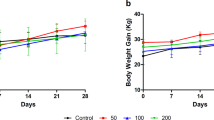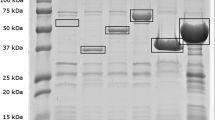Abstract
IT has been shown by many workers that the regular administration of very small doses of most antibiotics, including penicillin, will significantly increase the rate of growth of many species of animals. Extensive investigation, however, has not clearly demonstrated the mechanism or mechanisms by which such a benefit is derived, although it is generally considered that the mode or modes of action are entirely dependent upon the antibacterial activity of the antibiotic employed1. It has been suggested, however, that autoclaved penicillin when given by daily injection, but not by mouth, will increase the growth-rate of chicks2.
This is a preview of subscription content, access via your institution
Access options
Subscribe to this journal
Receive 51 print issues and online access
$199.00 per year
only $3.90 per issue
Buy this article
- Purchase on Springer Link
- Instant access to full article PDF
Prices may be subject to local taxes which are calculated during checkout
Similar content being viewed by others
References
Jukes, T. H., and Williams, W. L., Pharmacol. Rev., 5, 381 (1953).
Elam, Gee and Couch, Proc. Soc. Exp. Biol., N.Y., 8, 832 (1951).
Ministry of Agriculture Advisory Leaflet No. 104, Pig Feeding, p. 2 (H.M.S.O., London, 1953).
Fell and Stephenson, Poultry Sci., 32, 1092 (1953).
Author information
Authors and Affiliations
Rights and permissions
About this article
Cite this article
TAYLOR, J., GORDON, W. Growth-promoting Activity for Pigs of Inactivated Penicillin. Nature 176, 312–313 (1955). https://doi.org/10.1038/176312a0
Issue Date:
DOI: https://doi.org/10.1038/176312a0
This article is cited by
-
Systematic profiling of the chicken gut microbiome reveals dietary supplementation with antibiotics alters expression of multiple microbial pathways with minimal impact on community structure
Microbiome (2022)
-
Accumulation of genetic variants associated with immunity in the selective breeding of broilers
BMC Genetics (2020)
-
Antibiotic perturbation of the murine gut microbiome enhances the adiposity, insulin resistance, and liver disease associated with high-fat diet
Genome Medicine (2016)
-
Antibiotics in early life and obesity
Nature Reviews Endocrinology (2015)
-
Antik�rperbildung und Antibiotica
Zeitschrift f�r Kinderheilkunde (1958)
Comments
By submitting a comment you agree to abide by our Terms and Community Guidelines. If you find something abusive or that does not comply with our terms or guidelines please flag it as inappropriate.



